Tibetan Artist Nyima Tsering
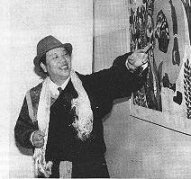 The exoticness in the Tibetan artist Nyima Tsering's paintings is certainly a great attraction. But when you look more closely, you will be stuck by the most profound meaning lying behind the colors, which bring alive the living and flourishing history of the Tibetan people, their optimism and aspirations.
The exoticness in the Tibetan artist Nyima Tsering's paintings is certainly a great attraction. But when you look more closely, you will be stuck by the most profound meaning lying behind the colors, which bring alive the living and flourishing history of the Tibetan people, their optimism and aspirations.
Tibetan paintings, such as rock paintings, tangka paintings and Buddhist script prints, are closely related to religion as far as motifs and means are concerned. Tibetan painters were mostly monks, who had inherited the art from their forefathers. In the past 40 years, however, Tibetan painting has grown independent of the religious culture. Nyima Tsering is one of those Tibetan artists who have been after the goal of making Tibetan painting an independent art.
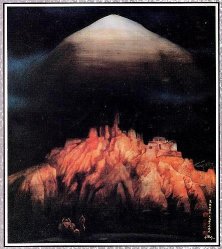 Nyima's works reflect the impact of Tibetan culture as well as the combined influence of Chinese and Western fine arts. He has managed to put a new spirit into the age-old Tibetan painting tradition.
Nyima's works reflect the impact of Tibetan culture as well as the combined influence of Chinese and Western fine arts. He has managed to put a new spirit into the age-old Tibetan painting tradition.
In Life, Nyima Tsering portrays an old Tibetan mother planting a tree in the red dirt of a harsh and barren environment. The tree is a symbol of life and the spirit of the Tibetan people. The artist reveals the Tibetans' aspirations of bringing life into the world however hard the environment may be. In the painting, every stroke is soaked with the painter's deep feelings for his ethnic people. He has expressed the same feeling in The Yuan Dynasty and Tubo Negotiate Peace and other works.
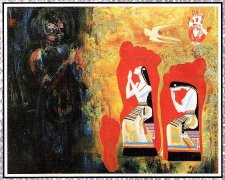 Nyima's works also explore the human nature without regard to time, space or border. The Final Holy Land is an example to represent the last holy land in a world of plagues and wars, where there are no disguises, no treachery and no intrigues and people live by their devout beliefs.
Nyima's works also explore the human nature without regard to time, space or border. The Final Holy Land is an example to represent the last holy land in a world of plagues and wars, where there are no disguises, no treachery and no intrigues and people live by their devout beliefs.
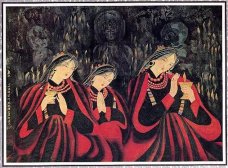 Since Nyima's paintings are very different from the traditional religious paintings, some religious painters have criticized him. In a long time after his graduation from the Sichuan Academy of Fine Arts in 1962, the Tibetan people did not recognize his paintings. Then he had to turn to the tradition of Tibetan painting and made a point of combining the traditional skills of his ethnic group with modern techniques. Owing to a decade's experimenting, he eventually fought his way out.
Since Nyima's paintings are very different from the traditional religious paintings, some religious painters have criticized him. In a long time after his graduation from the Sichuan Academy of Fine Arts in 1962, the Tibetan people did not recognize his paintings. Then he had to turn to the tradition of Tibetan painting and made a point of combining the traditional skills of his ethnic group with modern techniques. Owing to a decade's experimenting, he eventually fought his way out.
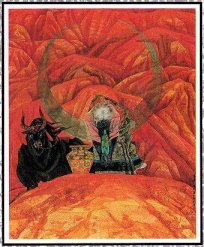 Nyima once said he liked the works by some Western masters of art such as Van Gogh, but would not simply clone them because what he wanted to learn from Western art was not the techniques but the core. It is, perhaps, his uniqueness that has led his paintings to win acclaim from audience from various parts of the world.
Nyima once said he liked the works by some Western masters of art such as Van Gogh, but would not simply clone them because what he wanted to learn from Western art was not the techniques but the core. It is, perhaps, his uniqueness that has led his paintings to win acclaim from audience from various parts of the world.
In the past years, Nyima has made extensive exhibition tours in India, the United States and European countries. A Swiss Tibetologist, after enjoying his paintings, comments, "As a Tibetan artist, Nyima Tsering should be called a genius. I have never known a Tibetan artist who has rendered the Buddhist tradition and modern Tibet more fascinatingly and vividly."
 Nyima Tsering's achievements in research on and creation of the new Tibetan paintings are deemed as great contributions to the development of the world's culture and have, therefore, led to his inclusion in the 500 World Celebrities compiled by the Cambridge International Biographical Center and the American International Biographical Institute.
Nyima Tsering's achievements in research on and creation of the new Tibetan paintings are deemed as great contributions to the development of the world's culture and have, therefore, led to his inclusion in the 500 World Celebrities compiled by the Cambridge International Biographical Center and the American International Biographical Institute.
Written by Ye Qinfa, published on 11/08/2000.
Also read Tibetan Food Today.
Related:

